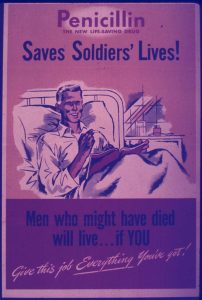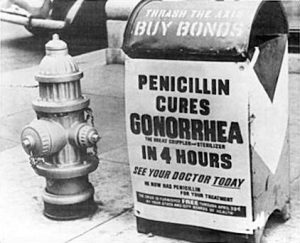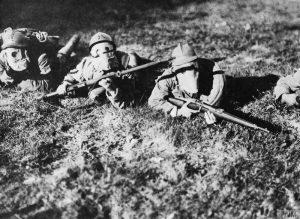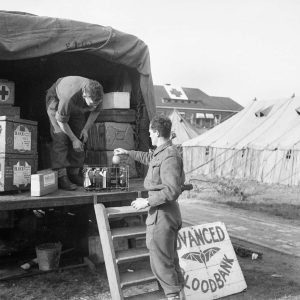World War I & II
71 Medical Advancements Caused By WWII
Christopher Rebar and Isabelle Martinez
Introduction
World War I (1914-1918) and World War II (1939-1945) are exceptionally well known for the high level of world powers involved, the devastating casualties and the significant level of human injuries. Not only did these wars impact the world politically and socially, but they also had life-changing impacts on medicine and technology.
World War II, specifically, is known as the deadliest conflict in human history, which allowed it to spur the creation of significant medical advancements due to the urgent demand for quick medical treatment in a time of large-scale casualties. These included advances in trauma treatment, developments in new medical techniques and the production of antibacterial treatments (Burton, 2025). Everything from dental practices to healing gunshot wounds was improved during the war and brought back to the civilian world. We can trace some of today’s best medical innovations to their fundamental discoveries during this war.
connection to sts
Medicine is one of the largest industries that combines science, technology and society. The World Wars provided an environment for significant advancement among devastations of war. The results of the changes during this time will be long-lasting. The modern world of healthcare as we know it today was shaped and transformed by innovations discovered during WWII. One of the most prominent examples of this connection is the war’s influence on promoting government funding of medical research. This led to vaccines, cancer research, surgical innovations and rehabilitation techniques. Not only were these advancements used in the military, but they were also implemented in the civilian world quickly after the war. In addition, the view of the soldier’s health was positively influenced. The shift of a soldier from a weapon to a person was evident in the increase in dental health, studies about chemical warfare effects and rehabilitation hospitals to serve soldiers post-war.
Penicillin: the most notable medical advancements
One of the most famous medical advances from WWII is the use of antibiotics (Phillips, 2023). The mass production of penicillin during World War II marked a significant medical breakthrough. Penicillin, the first widely used antibiotic, was crucial in treating bacterial infections and saved countless lives. It became widely available in the latter half of the war and revolutionized the treatment of wounds and infections. Between WWI and WWII, the survival rate for people who were sick or injured rose by 46% (Phillips, 2023).

The discovery occurred in 1928 by a bacteriologist at St. Mary’s Hospital in London, Alexander Fleming (Institute of Biomedical Science 2025). He found Penicillium notatum was a mold that could kill a wide range of bacteria. The substance this mold produced, later known as penicillin, became a point of interest in the potential creation of antibiotics. Over time, the research and use of this substance have increased. Finally, in 1940, Howard Florey and Ernst Boris Chain successfully purified penicillin and effectively proved its use in treating bacterial infections in mice (Institute of Biomedical Science 2025).
As World War II began, the need for quick and effective treatment became extremely urgent within the next few years. Both the British and American governments combined realized the potential of using this newly found substance to treat infected soldiers. This prompted the US funding for Florey and Chain to work with pharmaceutical companies to mass-produce penicillin. In World War II, penicillin effectively treated many bacterial infections, including wounds and pneumonia. Due to the funding and the beginning of mass production, by the time of D-Day landings in June 1944, there was enough penicillin to treat all the Allied forces (Institute of Biomedical Science 2025).

other breakthroughs
In addition to the production of antibiotics, World War II introduced many other medical advancements that would transform medical care as the world had known it. Many revolved around the quick treatment required for soldiers due to high numbers of injuries and diseases. These advancements would shape trauma care, infection control, surgery and rehabilitation.
Metal plates for healing bones: During treatment in WWII, doctors began attaching pins and plates to bones to provide control in bone reattachment. This advancement was discovered through X-ray imaging of German prisoners of war and was then implemented in American rehabilitation. It was reported that through this technique, soldiers could return to work in half of the time as before (Phillips, 2023).

Air Evacuations: The US Armed Forces relied on air evacuations for the first time on a large scale during WWII. The implementation became extremely vital in reducing the death rate among soldiers. This allowed for a decrease in amputations required as seriously injured soldiers received treatment faster.

Mobile Medical Units: The establishment of mobile medical units, often called MASH units (Mobile Army Surgical Hospitals), brought medical care closer to the front lines. These units were equipped with advanced medical facilities and were crucial in providing rapid and effective medical care to wounded soldiers.
Preventative medicine: The wide-scale use of vaccines was another determining factor in the lowering of death rates of soldiers during WWII. Bacterial infections were common among soldiers and civilians due to the proximity to living conditions and lack of hygiene. Research for preventive medicines was at the forefront of the war effort, and increased funding led to the development and implementation of vaccines among soldiers. These included inoculations against influenza, tetanus, cholera, malaria, smallpox, typhoid, yellow fever and even bubonic plague (Phillips, 2023).

Invention and development of Chemotherapy: Mustard gas was a standard chemical weapon used in both wars. During World War II, the research into this chemical weapon unexpectedly led to the development of chemotherapy. Soldiers exposed to this chemical were showing signs of healthy cell death and experienced toxic changes in their bone marrow composition (History of Cancer Treatments 2014). Throughout studies of other chemicals similar to mustard gas, scientists found that nitrogen mustard could effectively shrink tumors in lymph nodes (History of Cancer Treatments 2014). While this was just the beginning of the treatment we now know as chemotherapy, research done in WWII laid the groundwork.

Blood Transfusions and Blood Banking: The demand for blood transfusions during the war led to the establishment of blood banks and improved techniques for storing and transporting blood. While the idea of blood transfusion occurred during World War I, the large-scale storage and transport of blood was driven by World War II. Dr. Charles Drew played a massive role in developing these large-scale banks, which changed blood transfusion technology as it had been previously known. The National Research Council and American Red Cross planned national blood donation drives to create kits of dried plasma for use on the front lines. This banking system allowed for a vital resource in treating shock and blood loss patients, ultimately reducing mortality rates.
Advancements in Surgery: World War II saw advancements in surgical techniques, particularly orthopedic and plastic surgery. The need to treat complex injuries, including fractures and burns, led to innovations in reconstructive surgery and new materials and techniques for bone and tissue repair.
Dental Health: After WWI, America learned the results of poor oral hygiene in the overall health of soldiers. This promoted the implementation of routine dental examinations and treatment during WWII, leading to improved dental care practices and overall oral health. For the first time, soldiers had to brush their teeth at least once daily. The U.S. government issued soldiers hygiene kits, including toothbrushes, toothpaste, and toothpaste (The Evolution of Oral Hygiene 2024).
Amputation Techniques and Prosthetics: Advances in amputation techniques and the development of more functional prosthetics occurred during World War II. Improved materials and designs for artificial limbs contributed to better rehabilitation for amputees. At the end of WWII, the Army Prosthetic Research Laboratory was established to research and develop artificial hands (Dougherty & DeMaio, 2014).
Conclusion
These medical advancements made during World War II not only saved lives on the battlefield but also had a lasting impact on civilian healthcare, contributing to the foundation of modern medicine. While WWII is known as the deadliest conflict in history, we can look at the positive outcomes of such a dark time. The intense environment promoted the urgent need for new technology in regards to human health and allowed the final push for increased funding to get these.
Chapter Questions
Multiple Choice: Which scientist first discovered the potential of Penicillin?
a) Alexander Fleming
b) Edward Jenner
c) Howard Florey
d) Charles Drew
Short answer: What are two medical advancements made during WWII that acted as a foundation for modern medicine?
Short answer: What were mobile medical units often referred to as?
References
Everts, S. (2023, June 2). A brief history of chemical war. Science History Institute. https://sciencehistory.org/stories/magazine/a-brief-history-of-chemical-war/.
R.L., A. (2006, August). Review of The medical response to trench nephritis in world war 1. Web of Science.
Samuel, L. (2017, November 10). 6 medical innovations that moved from the battlefield to mainstream medicine. STAT. https://www.statnews.com/2017/11/10/medical-innovations-war/#:~:text=War%20also%20brought%20about%20the,respect%2C%20production%2C%20and%20use.
Vergun, D. (2020, March 17). Medical improvements saved many lives during World War II. U.S. Department of Defense. https://www.defense.gov/News/Feature-Stories/story/Article/2115192/medical-improvements-saved-many-lives-during-world-war-ii/.
World to benefit by war medicine. (1918, December 29). New York Times. Retrieved October 8, 2023, from https://www.proquest.com/hnpnewyorktimes/docview/99988999/242C66EA17FB423CPQ/2?accountid=6167.
World War 2 weapons. World War 2 Weapons. (n.d.). http://www.history-of-american-wars.com/world-war-2-weapons.html.
Kristen D. Burton, PhD. The Scientific and Technological Advances of World War II Retrieved April 6, 2025, from https://www.nationalww2museum.org/war/articles/scientific-and-technological-advances-world-war-ii
Phillips, Bethaney. (2023 May). Here’s how wars have changed modern medicine. We are the Mighty. Retrieved from https://www.wearethemighty.com/mighty-history/heres-how-wwi-changed-modern-medicine/
Institute of Biomedical Science. (2025 January 6). Penicillin: The war-time miracle drug that saved Millions. Retrieved on April 7, 2025 from, https://www.ibms.org/resources/news/penicillin-the-war-time-miracle-drug-that-saved-millions/
US Department of Veterans Affairs, V. H. A. (2013, December 12). Va.gov: Veterans Affairs. Protect your health. https://www.publichealth.va.gov/exposures/mustardgas/#:~:text=Mustard%20gas%20experiments,exercises%20over%20contaminated%20ground%20areas.
History of cancer treatments: Chemotherapy. American Cancer Society. (2014, June 12) Retrieved on April 7, 2025 from https://www.cancer.org/cancer/understanding-cancer/history-of-cancer/cancer-treatment chemo.html#:~:text=During%20World%20War%20II%2C%20naval,the%20lymph%20nodes%20called%20lymphoma.
The evolution of Oral Hygiene: How World War II changed America’s Dental Care Habits. Welcome. (2024, October 14). https://www.grandlakedental.com/blog/2024/10/14/the-evolution-of-oral-hygiene-how-world-war-ii-changed-america_s-dental-care-habits/#:~:text=World%20War%20II%3A%20A%20Shift%20in%20Dental%20Care%20Priorities&text=For%20the%20first%20time%2C%20toothbrushing,%2C%20toothpaste%2C%20or%20tooth%20powder.
Dougherty, P. J., & DeMaio, M. (2014). Major General Norman T. Kirk and amputee care during World War II. Clinical orthopaedics and related research, 472(10), 3107–3113. https://doi.org/10.1007/s11999-014-3679-6
Images cited
“Penicillin The New Life Saving Drug” by Picryl is in the Public Domain
“Penicillin cures Gonorhea” by Hohum is in the Public Domain
“Royal Air Force Ground Crew” by Royal Air Force official photographer, Trievnor J (Fg Off) is in the Public Domain
“Evacuations Under Fire in Korea” by National Museum of Health and Medicine is licensed under CC BY 2.0
“Chemical Warfare in the Twentieth Century” by Picryl is in the Public Domain
“Blood Supplies being drawn from advanced blood bank” by Picryl is in the Public Domain
AI Use disclosure
Resources such as scite.ai and ChatGPT were used to find sources during the first draft. However the chapter was heavily edited without the use of AI for the final product.

